WORLD CLASS COACHING
Soccer Intelligence
By Jason Carney
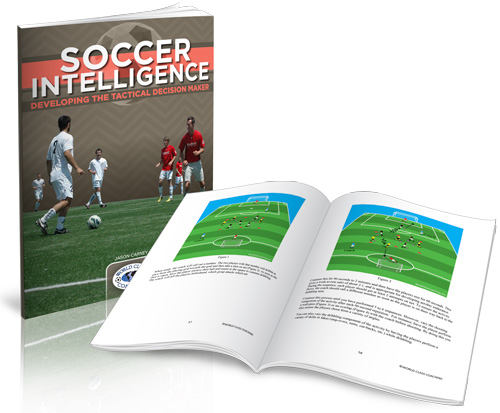
TABLE OF CONTENTS
Part Three
TECHNICAL PRACTICE - RUNNING WITH THE BALL
Technical practice sessions
Shooting, running with the ball and dribbling
Every player, whether it be a defender, midfielder or forward loves to shoot at goal. We need full focus from coaches and players when running these sessions because we want all our hard work on the field to pay off with a goal. We have to create real game situations for the attackers by adding defenders. This will give the attacker a feel of what move, shot or pass to make in that given situation. This type of training is helping to create a decision maker. The attacker also gets used to different defensive pressures and will be challenged to solve many different situations and also work out which technical skills to use to get out of trouble.
The difficulty for coaches is that this may involve standing in lines. Shooting exercises have to be stimulating and quick rotation so that coaches can avoid players standing in line for long periods of time. The way to avoid the long lines are to run numerous shooting stations if possible or run stations with different topics so players are rotating from station to station. A lot of thought has to go into running a quality shooting session.
Key factors for a shooting session:
• Make sure your session has rhythm. Players will be waiting in lines. Make sure it’s not for long.
• Have plenty of soccer balls.
• Encourage. Do not criticize. If you criticize, the shooter will be reluctant to take the shot.
• Stimulate the players with your personality and enthusiasm. Also, be creative in the session that you are planning.
• Move the session from a technical, no defenders exercise to a real game situation exercise.
• The ball should always be moving before the shot is taken. In a game, apart from set pieces, it’s very rare that the ball is motionless when players shoot.
Key factors for shooting: The player
• Take special attention to the first time shot. This shot has power, speed and a surprise factor for the goalkeeper.
• Timing of the shot. Players work out the distance and positioning of the goalkeeper before taking the shot.
• Choose a target. Look where the goalkeeper is positioned.
• If you are passing to a player that is in a better position than you, work out the type of pass, the accuracy of the pass and the timing of the pass.
• Have a strong mental attitude. “If I miss, I’ll get the next one.”
Learning environment:
• Understand the timing of stepping in to coach (Young players do need more structure than usual) As coaches, we have to deal with effort first. We have to teach the players of today to give 100% effort. Do their best.
• Allow players to explore and problem solve during practice
• Present information. VISUALLY, VERBALLY AND BY DEMONSTRATING.
• Don’t always offer an immediate solution.
• Teach your goal keepers to play out from the back
• Have breaks to discuss strategies and tactics for solving game related problems
• Give frequent praise for good play AND effort, relating praise to specific actions
The following sessions can always be followed with a small sided game. At the foundation phase of development, we want the players to enjoy the game and learn the techniques of becoming an improved soccer player. You will soon see the players performing the techniques in the small sided games. Players have to be given the freedom to be self-taught.
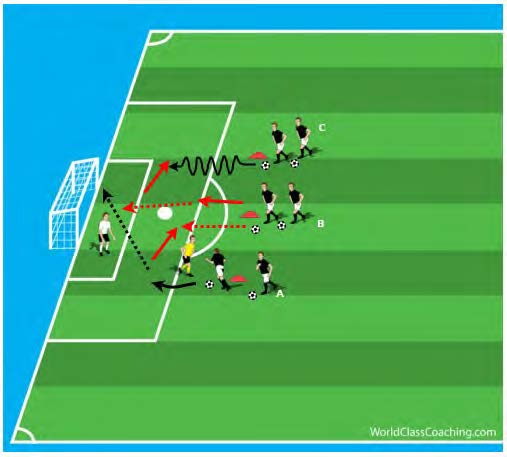
Shooting, passing and 1v1
Exercise:
• Area: Three cones 20 yards away from goal with three groups of players. All the players have a soccer ball.
1. Player A starts the exercise by dribbling around the coach and shoots at the goal.
2. As soon as Player A has taken the shot, they turn and receive a pass from Player B.
3. Player A now passes to running player B who shoots at the goal.
4. Player A now joins another group.
5. After taking a shot, player B now plays a 1V1 against player C.
6. Players rejoin a new group of players.
Variations:
• Practice both directions.
Coaching points:
• Pass the ball accurately to the correct foot or space.
• The tempo of passing must be game related.
• Shot at the goal. Choose a target.

Passing and 1v1 with the GK
Exercise:
• Area: 40 x 40 with two teams working at the same time. Two goals with goalkeepers. Play starts at position ‘A’ with the players each having a soccer ball.
1. Player A starts the exercise by passing to ‘checking’ player B.
2. Player B receives the ball on the back foot and passes to running player C..
3. Player C plays a 1v1 against the goalkeeper. After shooting player C joins group ‘A’.
4. Players follow the pass.
Variations:
• Start from position C
Coaching points:
• Pass the ball accurately to the correct foot or space.
• The tempo of passing must be game related.
• Player C take a touch that will affect the goalkeepers position before shooting.
• Shot at the goal. Choose a target.
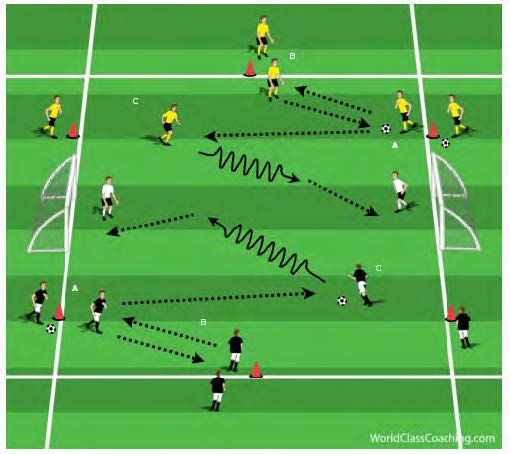
Passing and 1v1 with the GK - Variation # 1
Exercise:
• Area: 40 x 40 with two teams working at the same time. Two goals with goalkeepers. Play starts at position ‘A’ with the players each having a soccer ball.
1. Player A starts the exercise by passing to ‘checking’ player B.
2. Player B receives the ball and passes back one touch to player A.
3. Player A passes long to running player C.
4. Player C plays a 1v1 against the goalkeeper. After shooting player C joins group ‘A’.
5. Players move to the next cone.
Variations:
• Start from position C
Coaching points:
• Pass the ball accurately to the correct foot or space.
• The tempo of passing must be game related.
• Player C take a touch that will affect the goalkeepers position before shooting.
• Shot at the goal. Choose a target.
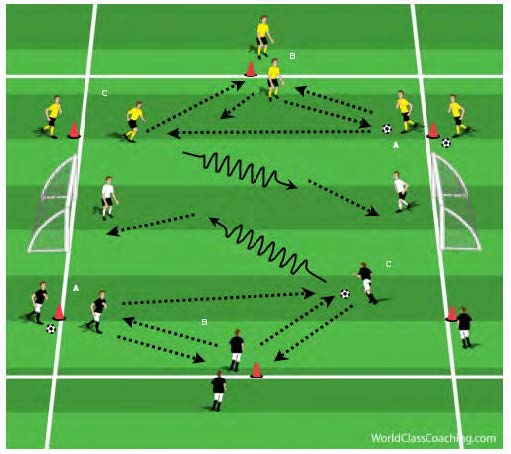
Passing and 1v1 with the GK - Variation # 2
Exercise:
• Area: 40 x 40 with two teams working at the same time. Two goals with goalkeepers. Play starts at position ‘A’ with the players each having a soccer ball.
1. Player A starts the exercise by passing to ‘checking’ player B.
2. Player B receives the ball and passes back one touch to player A.
3. Player A passes long to running player C.
4. Player C now plays a give and go with player B.
5. Player C plays a 1v1 against the goalkeeper. After shooting player C joins group ‘A’.
6. Players move to the next cone.
Variations:
• Start from position C
Coaching points:
• Pass the ball accurately to the correct foot or space.
• The tempo of passing must be game related.
• Player C take a touch that will affect the goalkeepers position before shooting.
• Shot at the goal. Choose a target.
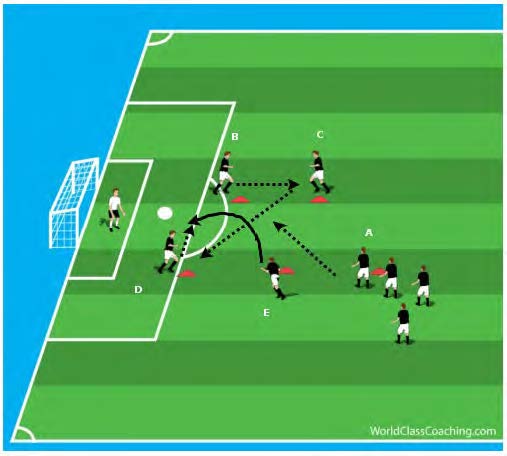
Passing, moving and shooting
Exercise:
• Area: Set up 5 cones as shown. The distance from goal will depend on the ability of your players.
1. Player A starts the exercise. Player A passes to player B.
2. Player B drops the ball back to player C.
3. Player C now passes long to player D.
4. Player D now plays the ball to running player E.
5. Player E shoots at goal.
6. Players move to the next station while the shooting player E retrieves the ball and moves to the starting position A.
Variations:
• Move the cones to the other side of the goal. See if the players can work out the passing sequence?
Coaching points:
• Pass the ball accurately to the correct foot or space.
• The tempo of passing must be game related.
• Timing of the run by player E.
• Shot at the goal. Choose a target.
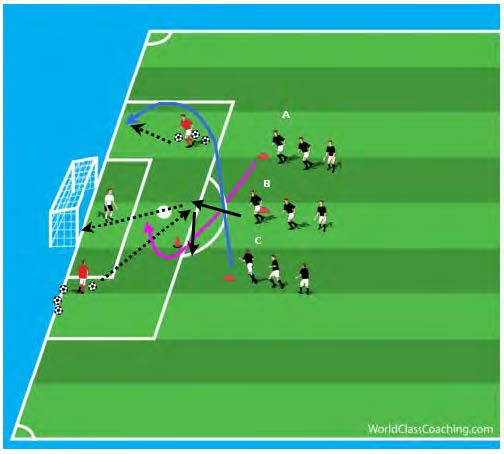
Crossing and finishing
Exercise:
Area – 20 yards from goal. Three stations. Three players go at the same time, one from each station.
Two servers and one Goalkeeper. The servers have all the soccer balls. A cone is placed on the edge of the 18 yard box at the corner of the D. This is to help players with their movement.
• Station A – This player runs around the far cone and attacks the front post.
• Station B – This players receives a pass from the coach situated by the post and takes a shot. After the shot, he / she moves around the far cone and attacks the back post.
• Station C – This player makes an overlapping run, receives a pass from the server and then crosses it for the two players.
• Players change station after each exercise is done.
Variations:
• Practice both directions. (You may want to remove the cone on the edge of the 18 yard box)
• Add a defender
Coaching points:
• The player crossing the ball has to choose which attacker to cross to and what type of cross.
• Shot at the goal. Choose a target.
• Timing of the run to front and back post. These players are staggered, not in a line. The player crossing the ball can either choose front post run or back post player.
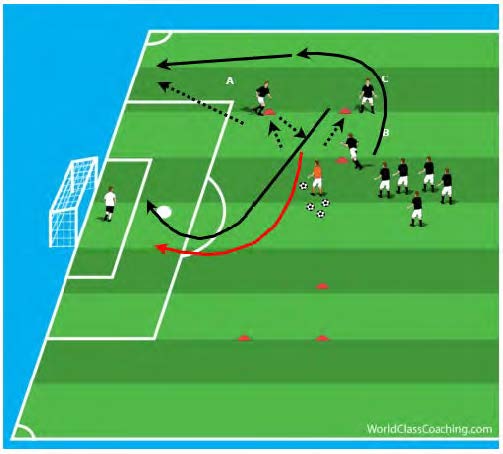
Crossing and finishing with movement
Exercise:
Area – Three cones spaced out on the edge of the 18. Three players stand on a cone. The coach has all the soccer balls. There is a goalkeeper in goal.
• The coach passes the ball to player A.
• Player A passes to player B and then moves to the middle of the grid with an open body position.
• Player B passes to player C and goes on an overlap.
• Player C passes to player A and then runs to attack the front post.
• Player A passes into space for overlapping player B and then attacks the box (back post)
• Player B crosses the ball to one of the attacking players.
Variations:
• Practice both directions.
• Add a defender
Coaching points:
• The player crossing the ball has to choose which attacker to cross to and what type of cross.
• Shot at the goal. Choose a target.
• Timing of the run to front and back post. These players are staggered, not in a line.
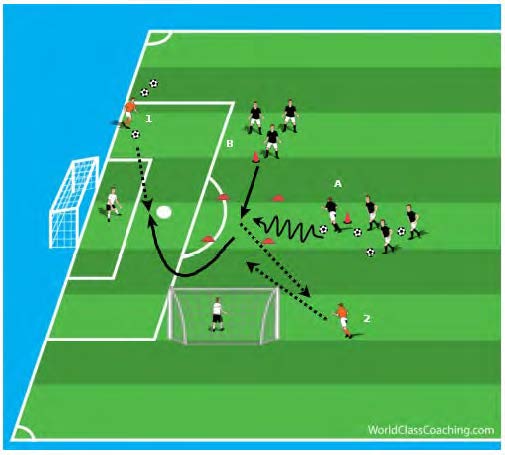
Shooting technique from a cross
Exercise:
Area: 40 x 40 area, two goals with goalkeepers. Two servers. Server 1 has soccer balls and server 2 does not. Team A also has soccer balls. Team B does not. A 5 x 5 grid in the central area.
1. Team A players each have a soccer ball.
2. First player in line A, dribbles the ball into the square and stops the ball with the sole of his / her foot.
3. Line A player now makes an arc run and receives a cross from server 1 and shoots at goal.
4. As soon as the ball is stopped in the 5x5 area, the player in line B runs to the ball and plays a wall pass with server 2 and shoots.
5. Once the exercise is performed, players join the opposite group.
Coaching points:
• Player in line A: Once the ball is stopped in the 5 x 5 area, they make an arched run before receiving a cross from server 1 (You can add a cone for them to run around if needed.)
• Body shape and shooting technique.
• The exercise has to performed at game speed.
• While playing a game, it is very rare that players shoot a ball, that is not moving.

Running with the ball and shooting
Exercise:
Area – 25 x 30, 2 goals with goalkeeper’s. Each player has a soccer ball.
1. First player from each group dribbles towards the cone, performs a fake move at the cone and shoots at the goal.
2. They then get their ball and join the opposite group.
3. Move the teams to the other cone to work on their opposite foot. Same drill is conducted.
Variation:
1. Red line: One player at a time. First player dribbles and shoots.
2. After they take the shot, the next player from the opposite group starts.
3. The player who has taken the shot sprints across to tackle the shooting player. If the player gets tackled, or takes a shot, they then chase the player from the other team who has begun the exercise..
4. After the chase, they then join their own group.
5. So, “After a shot, you chase!!”
Coaching points:
• Striking the ball with your laces.
• Shoot across the GK.
• Play at “game speed”.
• Player’s intelligence, once they shoot, they chase. (It’s copying a loss of possession in a game. Looking for reactions.)
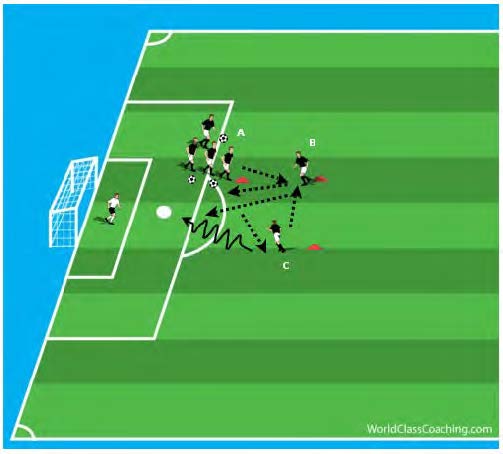
Passing / shooting technique
Exercise:
• Area: 15 x 15 o20 yards from goal..
• Exercise shows 5 players. (Can be done with more players. Use another station)
1. Player A passes the ball to player B and shows for the return pass.
2. Player B passes back to Player A who makes a diagonal pass to Player C.
3. Player C passes to player B and makes a run towards the goal.
4. Player B passes to running Player C.
5. Player C shoots at the goal.
6. Player A moves to position B and Player B moves to position C.
Variations:
• Practice both directions.
• Add a defender
Coaching points:
• Pass the ball accurately to the correct foot or space.
• The tempo of passing must be game related.
• Accuracy, weight and timing of pass.
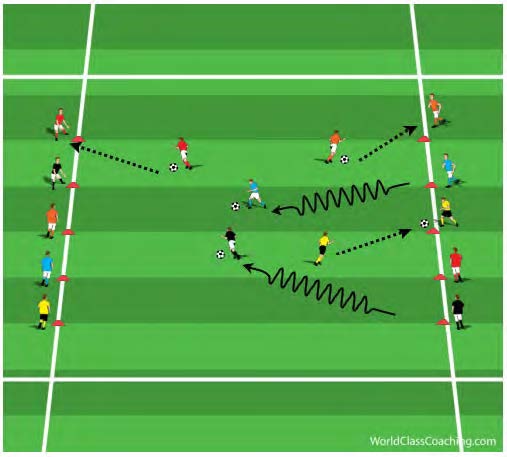
Running with the ball then pass
Exercise:
• Area: Two lines 25 yards apart. Players are put into groups of three with one ball between the three. Teams can be organized in colors or by names.
1. To start, one player is positioned on each end line with the third player in the middle with the ball.
2. All players remember who is in their group.
3. The middle player runs with the ball and passes to one of their team mates. The passer swaps places with the player they passed to.
4. The receiving player scans the field and runs with the ball to the other player, that is part of their three man team.
Variations:
• Keep having the outside players move into new positions. The team of three stays the same.
Coaching points:
• First touch is taken in the direction you are heading.
• Few touches while still being in control of the ball.
• Speed.
• Use the laces to move the ball on and lift your head to look where your team-mate is.
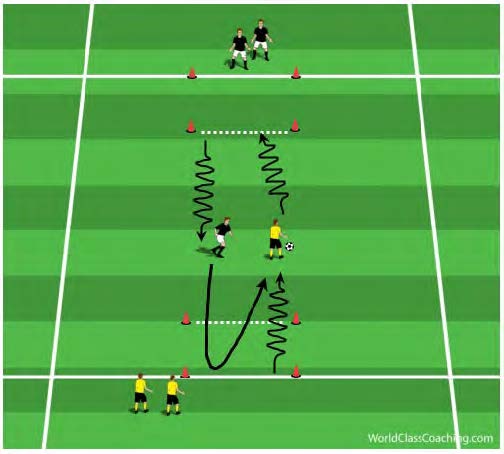
Running with the ball while being chased
Exercise:
• Area: Groups of six in two teams of three are shown. One soccer ball is used. You may have more than 6 players. Make more groups instead of having longer lines. The teams are 25 yards apart with another line 5 yards in (as shown)
1. The first player, with the ball at their feet, runs towards the opposite group.
2. They attempt to stop the ball on the first line.
3. As soon as they do this, the opposite player sets off and runs with the ball at their feet.
4. The player that has stopped the ball, runs to the end line and then chases the player.
5. The player that is chasing has to tag the other player that is running with the ball. No tackling.
6. Once the chase is over, that player joins the end of their own team line.
7. The sequence continues.
8. Every player ends up back with their own team-mates.
Variations:
• Swap the groups around
Coaching points:
• First touch is taken in the direction you are heading.
• Few touches while still being in control of the ball. Players have to attempt to stop the ball on the first line so being in control of the ball is important.
• Players will forget to chase (this will be fun) Once they stop the ball on the line, they chase.
• Speed.
• Use the laces to move the ball on and lift your head to look where your team-mate is.
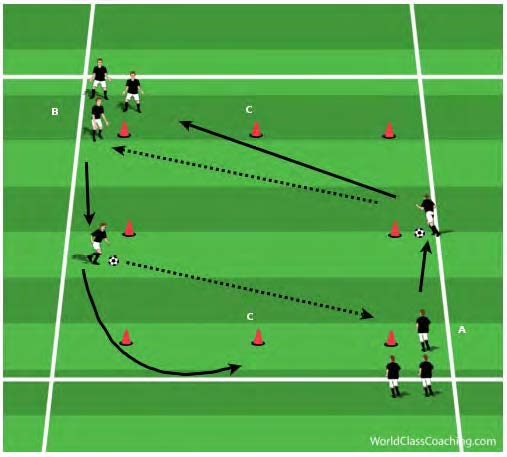
Running with the ball and passing
Exercise:
Area – 40 x 20, 2 teams, 2 soccer balls.
• Starting players A & B run with the ball. After passing the middle cone they pass diagonal to the player in the opposite group.
• Once they pass, they follow the pass and join the opposite group.
• After a few minutes, the teams move to the other side of the grid to work on their left foot and perform the same exercise. They are now using their left foot to make the pass.
Variations:
• Same exercise as above but once the player makes the pass, they touch cone C and chase the player they passed to, then rejoin their own group. Once you make your pass, YOU CHASE.
Do not have the players tackling the players they are chasing. They just have to tag them. Keep the exercise moving
Coaching points:
• Few touches when running with the ball.
• Body shape when receiving a pass.
• First touch.
• Pass the ball in front of the receiving player.
• Have fun
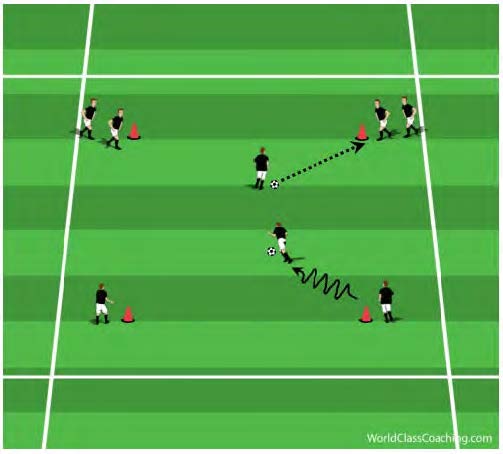
Dribbling and turning
Exercise:
• Area: Cones are set up 20 yards apart. The players are spread out evenly on the four cones. This exercise shows 8 players. Have numerous stations working if you have more players. Avoid long lines of players waiting around.
1. Groups work diagonally with each other.
2. Demonstrate to the group at least 4 turns they can perform.
3. First player with a ball dribbles to the middle, performs a turn, then another turn, then passes and follows to opposite group.
4. Can the players perform two different turns in the middle?
5. Allow them to be creative.
Variation:
• The player dribbles to the middle, performs a turn and passes back to the first player from the group they just came from. They then create an angle and receive the ball back. They control the ball with their back foot, pass and follow to the opposite group.
Coaching points:
• Enthusiasm from the coach
• Quality of turn
• Passing – Accuracy, weight, timing.
• Communication. Once the middle player performs their second turn, the next receiving players calls for the ball.
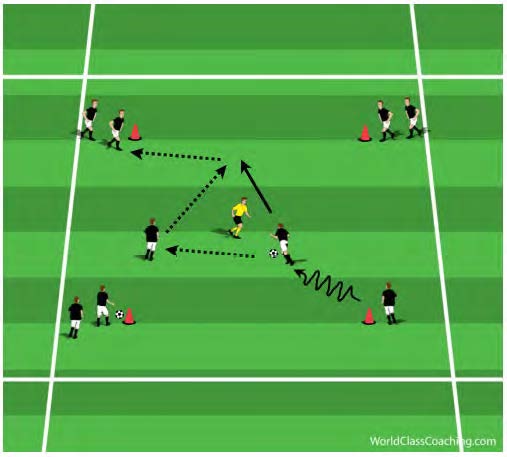
Dribbling, give and go
Exercise:
Area:20 x 20, 8 players, 2 balls. The coach plays as a defender. Add another player who plays wall passes.
1. First player dribbles towards the coach. Dribbling player plays a give and go around the coach.
2. Once the player has played the wall pass, the coach turns to the next player with the ball and the sequence continues.
Variation:
• Now give the player a choice. The dribbling player can now make a decision on whether they will play the give and go, or dribble around the coach by using their partner as a decoy.
Coaching points:
• Players perform one after the other (Coach has to be focused and so does the player who is in the middle playing the give and go’s)
• Encouragement and enthusiasm from the coach.
• Show player different moves.


